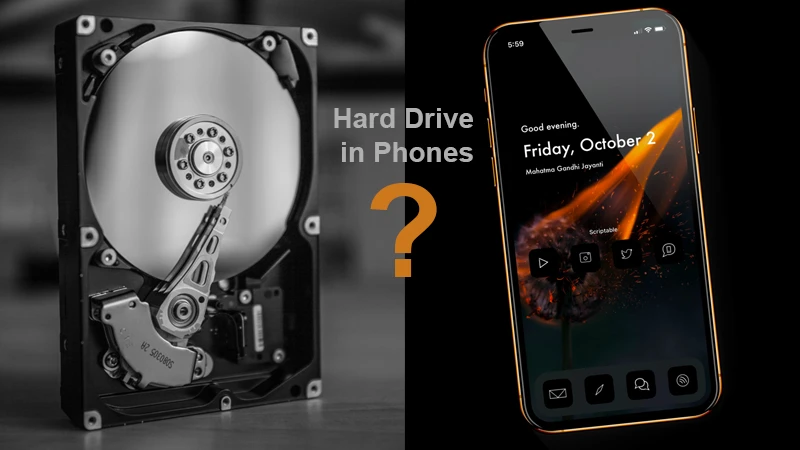Hard Disk Drive(HDD) is essential to store and retrieve information about the device’s usage and function. Chiefly the purpose of Hard Drive is to provide long-term storage of operating systems, software applications, and user data. So, every digital electronic device needs a Hard Drive to store the concerned information.
Is there a hard drive in phones?
Smartphones don’t contain any Hard Drive; they use flash memory, a type of non-volatile storage that retains data even when the power is turned off. It’s commonly used in USB drives, memory cards, and solid-state drives (SSDs).
Do you know the concept behind Hard Drive?
The history of data storage has evolved significantly from hard drives to smartphones. It began with the invention of hard disk drives (HDDs) in the 1950s, which used magnetic storage to store and retrieve digital information. Usually, platters of HDDs are paired with magnetic heads that read and write data to the surfaces.
Over the years, HDDs have become smaller, more efficient, and capable of storing increasing amounts of data.
In the 1980s, the introduction of solid-state drives (SSDs) marked a shift from magnetic storage to semiconductor-based storage, offering faster access times and improved reliability. SSDs gradually found their way into consumer electronics, including laptops.
Want to know more about SSD?
Solid State Drives(SSDs) are a type of data storage device that uses NAND-based flash memory to store and retrieve digital information. Unlike traditional Hard Disk Drives (HDDs) that rely on magnetic spinning disks, SSDs have no moving parts, making them faster, more durable, and energy-efficient.

SSDs are the fastest when compared to HDDs. They were initially more expensive than HDDs on a per-gigabyte basis, but as technology has advanced and manufacturing costs have decreased, the price gap has narrowed. SSDs are now more accessible to consumers and offer better value for performance.
Do smartphones consist of Hard Drives?
As mobile phones evolved into smartphones, the demand for compact and energy-efficient storage increased. NAND flash memory became the standard storage medium for smartphones due to its small form factor, fast access times, and low power consumption.
Expansion with MicroSD Cards: Some smartphones allow users to expand storage using removable microSD cards, which also use flash memory technology.
Integration of UFS and NVMe: The evolution continues with the integration of technologies like Universal Flash Storage (UFS) and Non-Volatile Memory Express (NVMe), further enhancing data transfer speeds in smartphones.
Today’s smartphones commonly use flash memory as their primary storage medium Because the ongoing development of storage technologies continues to shape the way we store and access data on mobile devices.
More about UFS:
UFS aims to provide a faster and more efficient alternative to eMMC (embedded MultiMediaCard) storage, commonly used in mobile devices before the introduction of UFS. It significantly offers data transfer speeds compared to eMMC. It employs a serial interface that enables high-speed communication between the storage device and the device’s processor.
Moreover, it is designed to be power-efficient, contributing to longer battery life in mobile devices. UFS incorporates advanced memory management features, including a command queue and the ability to manage simultaneous read and write operations more efficiently. This results in improved multitasking capabilities.
More about NVMe:
NVMe stands for Non-Volatile Memory Express, is a protocol designed for efficiently accessing and managing non-volatile memory, particularly NAND flash memory, in solid-state drives (SSDs). NVMe is a significant advancement over traditional storage protocols like SATA (Serial ATA) and is designed to leverage the full potential of high-speed NAND-based storage devices.
Mutually possesses a certain advantage of parallelism by allowing multiple queues and commands to be processed simultaneously. This parallel processing capability enhances the efficiency of data access and improves performance in multitasking scenarios.
Need to get Hard Drives in your Androids or iPhones?
Yes, you can use a USB OTG adapter to connect a hard drive to your Android device. Make sure your Android device supports USB OTG, and then you can connect the hard drive using the adapter. Some file manager apps on your Android device should allow you to access and manage files on the connected hard drive.
Apple iPhones do not natively support USB OTG as some Android devices do. However, you can use accessories like the Lightning to USB Camera Adapter to connect certain USB devices, including some external drives, to an iPhone. Because iOS has limitations on the types of files and how they can be accessed.
Bottom Up
Hard drives and flash memory serve the same purpose of storing and retrieving data, but their underlying technologies, speed, durability, form factors, and energy efficiency differ significantly, making each more suitable for certain applications and use cases.
FAQ’s
Have you heard of HDD in Smartphones?
No, Smartphones don’t possess any HDDs, instead they have flash memories, NAND flash memory became the standard storage medium for smartphones due to its small form factor, fast access times, and low power consumption. Expansion with MicroSD Cards, smartphones allow users to expand storage using removable microSD cards, which also use flash memory technology.
Which should be preferred either UFS or NVMe?
The choice between UFS and NVMe depends on the intended use case. UFS is geared towards mobile devices, providing a balance of performance and power efficiency. NVMe, on the other hand, is a versatile and high-performance solution used in a broader range of computing devices.

